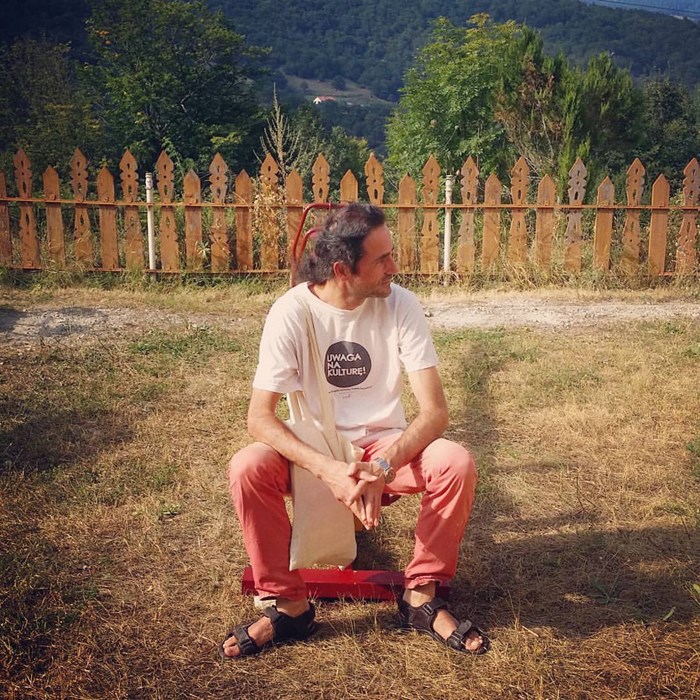
Vahram Aghasyan
born 1974
1990 - 2010s
1993-1999 studied at M.F.A. Yerevan Academy of Fine Arts, Yerevan, Armenia.
Aghsyan has exhibited internationally in the Tenth International Istanbul Biennial, the Museum Kiasma in Helsinki, First Contemporary Art Biennale of Thessaloniki. His works had been shown in “Contemporary video art from Armenia” Musee d’art Contemporain, Lyon, he was in the group show “Resistance through art” in the Armenian Pavilion at the 51st Venice Biennale 2005. His works are shown in the museum collections like M HKA, Museum of Modern Art, Antwerp, Belgium; Frac Bretagne, Rennes, France; Museum on the Steam, Jerusalem, and many others. He has 20 years of experience as curator, artist and theorist.
His solo exhibitions include “Text as a measure of space”, Kultur Kontakt, Vienna, Austria (1996), “TEXT”, Charlie Khachatryan Gallery, Yerevan (1998), “Ghost City” ACCEA, Yerevan
(2005), Vahram Aghasyan La maison neyrand, Lyon (2007), “Ruins of our times”, Gallery ALKATRAZ, Ljubljana, Slovenia (2010), “Signs of Future”, Tobachna Gallery, Ljubljana, Slovenia (2013).
“What is the correlation between time and contemporary art? Will contemporary artists succeed in overcoming the various events linked with politics, society and everyday life or is their work simply the digestion and analysis of the past? How successful are they in feeling and being aware of what is happening and linking it with the past and future? Could they be described as prophets who are marching not so much in step with time but slightly ahead of it? To what extent can contemporary art forecast the future?
These are the questions that arise on examining Vahram Aghasyan’s work. “Ghost Town”, “Bangladesh” and “Factories in the Heaven” are living pictures made up of symbols of the past, which are inherited by the present and pre-ordain the future. One of the characteristics of these three features of time is architecture, which is presented to us in the artist’s works in a single context but in various guises. The project “Ghost Town” (2005) is the culmination of the artist’s observations of time and, in this case, of time that has stood still and is frozen. On one hand as a consequence of the documentary depiction of this empty and yet unformed small town we sense a criticism directed against negligence and corruption (1). On the other hand a number of questions arise: what does this “ghost town” represent? What is its fate? Will this construction ever be completed or is this a type of “architectural monument” embodying an unrealisable dream?
The idea of unfinished architecture can also be found in such video works as “Block 16” (2003) and “Bangladesh” (2005). In “Block 16” the artist has locked onto some unfinished tall buildings from the eighties that stand like huge sculptures or installations. Bangladesh (2) is kind of curious inquiry into the severity and symmetry of high buildings, which at first glance don’t even appear to be inhabited. It is only on closer examination that one notices the traces of human life. In these works the artist reveals a dialogue, a rapport between people and architecture through which they co-exist together and influence each other. The artist’s interest in the outskirts of the city is not accidental because it is specifically here that one can see the best examples of pseudo-modernist architecture, which elicits pity, sadness and sympathy all at the same time. For it is the incompleteness and absurdity of these buildings that are devoid of any function that brings them close to art, where they finally acquire a function.
Poetry sits quite comfortably alongside the social content of Aghasyan’s work. It is very difficult to categorise him as a documentary maker because thanks to his poetic approach to reality, one can sense in his works a caution towards and an avoidance of dry and bare restraints through the use of such media as video and photography. This poetry is expressed in his slow tempo, in the absence of any sort of action, in freeze frames that lend a sad and melancholic mood to his video work and even in his use of poetic text itself.
If one were to trace Vahram Aghasyan’s work from its very beginnings to the present day then one could say that all of his work is united by a single philosophy – the philosophy of time. Because the unfinished nature of this architecture is what is so attractive to the artist due to the fact that it allows him to finish building it himself using his imagination. And this is a type of unfinished game, a game played with eternity”.*
1) This was one of the last Soviet projects, which were carried out by the government after the earthquake of 1988. The people who had lost their homes as result of the earthquake in Gyumri should have been settled in this small town.
2) The unofficial name “Bangladesh” was thought up by the inhabitants of this neighbourhood. It expressed what they thought about this block of buildings which were extremely hot and a long way from the centre of Yerevan but also cheap and easy to acquire.
*Excerpts from the text 'Playing with time and observing time' published in the catalogue of the exhibition 'Time of the storytellers. Narrative and Distant Gaze in Post-Soviet Art', KIASMA, Helsinki, 2007
Nationality
Armenian
Region
Armenia
City
Yerevan
Activity
contemporary art, conceptual photography
Media
digital photography, video art, moving image, photo-media installation
Bibliography
Kareyan, Davit. Resistance through art. Armenian pavilion 51st International Venice Biennale catalogue, 2005
Exhibitions
2005: Resistance through art. Armenian pavilion 51st International Venice Biennale